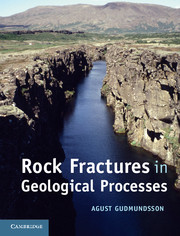Book contents
- Frontmatter
- Contents
- Preface
- Acknowledgements
- 1 Introduction
- 2 Stress
- 3 Displacement and strain
- 4 Relation between stress and strain
- 5 Loading of brittle rocks to failure
- 6 Stress concentration
- 7 Theories of brittle failure of rocks
- 8 Extension fractures and shear fractures
- 9 Displacements and driving stresses of fractures
- 10 Toughness and fracture mechanics
- 11 Field analysis of extension fractures
- 12 Field analysis of faults
- 13 Evolution of extension fractures
- 14 Evolution of faults
- 15 Fluid transport in rocks – the basics
- 16 Fluid transport in faults
- 17 Fluid transport in hydrofractures
- Appendix A Units, dimensions, and prefixes
- Appendix B The Greek alphabet
- Appendix C Some mathematical and physical constants
- Appendix D Elastic constants
- Appendix E Properties of some crustal materials
- Index
- References
2 - Stress
Published online by Cambridge University Press: 05 June 2012
- Frontmatter
- Contents
- Preface
- Acknowledgements
- 1 Introduction
- 2 Stress
- 3 Displacement and strain
- 4 Relation between stress and strain
- 5 Loading of brittle rocks to failure
- 6 Stress concentration
- 7 Theories of brittle failure of rocks
- 8 Extension fractures and shear fractures
- 9 Displacements and driving stresses of fractures
- 10 Toughness and fracture mechanics
- 11 Field analysis of extension fractures
- 12 Field analysis of faults
- 13 Evolution of extension fractures
- 14 Evolution of faults
- 15 Fluid transport in rocks – the basics
- 16 Fluid transport in faults
- 17 Fluid transport in hydrofractures
- Appendix A Units, dimensions, and prefixes
- Appendix B The Greek alphabet
- Appendix C Some mathematical and physical constants
- Appendix D Elastic constants
- Appendix E Properties of some crustal materials
- Index
- References
Summary
Aims
Fractures form when the stress in the rock becomes so high that the rock breaks. Stress is thus of fundamental importance for understanding rock fractures. Stress has already been defined (Chapter 1). Here the focus is on those aspects of stress analysis that are most useful for understanding rock fractures. The primary aims of this chapter are to:
Explain some of the concepts from stress analysis, particularly those relevant to rock fractures.
Clarify the difference between a stress vector (traction vector) and a stress tensor and the relationship between these concepts.
Define the principal stresses and principal stress axes and planes.
Explain the stress ellipsoid.
Discuss stresses on an arbitrary plane and Mohr's circles of stress.
Define mean stress and deviatoric stress.
Indicate and explain the use of some special stress states.
Define stress fields and stress trajectories and explain their use in stress analysis.
Some basic definitions
Stress at a point is a tensor of the second rank, whereas the stress on a plane is a vector, that is, the stress vector or traction (Chapter 1). The magnitude of a stress, given as, say, 10 MPa, is a scalar. Before we discuss the concept of stress in more detail, it is necessary to recall some basic definitions that are assumed to be known. This section, of necessity, must be brief. More details on tensors, vectors, and scalars are provided in some of the books listed at the end of this chapter.
- Type
- Chapter
- Information
- Rock Fractures in Geological Processes , pp. 28 - 62Publisher: Cambridge University PressPrint publication year: 2011



